Florin Curta has published online his draft for Eastern Europe in the Middle Ages (500-1300), Brill’s Companions to European History, Vol. 10 (2019), apparently due to appear in June.
Some interesting excerpts, relevant for the latest papers (emphasis mine):
The Archaeology of the Early Slavs
(…) One of the most egregious problems with the current model of the Slavic migration is that it is not at all clear where it started. There is in fact no agreement as to the exact location of the primitive homeland of the Slavs, if there ever was one. The idea of tracing the origin of the Slavs to the Zarubyntsi culture dated between the 3rd century BC and the first century AD is that a gap of about 200 years separates it from the Kiev culture (dated between the 3rd and the 4th century AD), which is also attributed to the Slavs. Furthermore, another century separates the Kiev culture from the earliest assemblages attributed to the Prague culture. It remains unclear as to where the (prehistoric) Slavs went after the first century, and whence they could return, two centuries later, to the same region from which their ancestors had left. The obvious cultural discontinuity in the region of the presumed homeland raises serious doubts about any attempts to write the history of the Slavic migration on such a basis. There is simply no evidence of the material remains of the Zarubyntsi, Kiev, or even Prague culture in the southern and southwestern direction of the presumed migration of the Slavs towards the Danube frontier of the Roman Empire.
Moreover, the material culture revealed by excavations of 6th- to 7th-century settlements and, occasionally, cremation cemeteries in northwestern Russia, Belarus, Poland, Moravia, and Bohemia is radically different from that in the lands north of the Danube river, which according to the early Byzantine sources were inhabited at that time by Sclavenes: no settlement layout with a central, open area; no wheel-made pottery or pottery thrown on a tournette; no clay rolls inside clay ovens; few, if any clay pans; no early Byzantine coins, buckles, or remains of amphorae; no fibulae with bent stem, and few, if any bow fibulae. Conversely, those regions have produced elements of material culture that have no parallels in the lands north of the river Danube: oval, trough-like settlement features (which are believed to be remains of above-ground, log-houses); exclusively handmade pottery of specific forms; very large settlements, with over 300 houses; fortified sites that functioned as religious or communal centers; and burials under barrows. With no written sources to inform about the names and identities of the populations living in the 6th and 7th centuries in East Central and Eastern Europe, those contrasting material culture profiles could hardly be interpreted as ethnic commonality. In other words, there is no serious basis for attributing to the Sclavenes (or, at least, to those whom early Byzantine authors called so) any of the many sites excavated in Russia, Belarus, Poland, Moravia, and Bohemia.
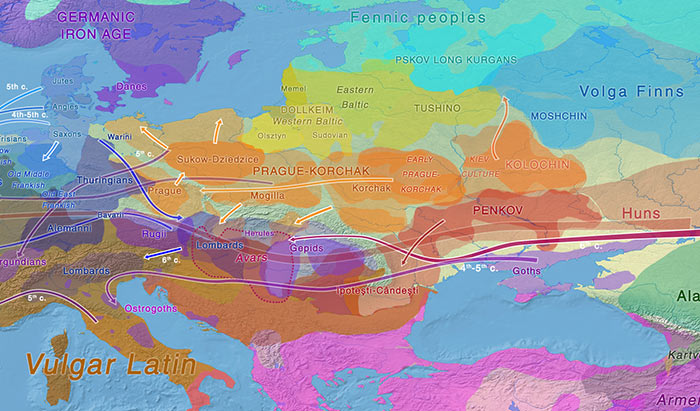
Migrations
There is of course evidence of migrations in the 6th and 7th centuries, but not in the directions assumed by historians. For example, there are clear signs of settlement discontinuity in northern Germany and in northwestern Poland. German archaeologists believe that the bearers of the Prague culture who reached northern Germany came from the south (from Bohemia and Moravia), and not from the east (from neighboring Poland or the lands farther to the east). At any rate, no archaeological assemblage attributed to the Slavs either in northern Germany or in northern Poland may be dated earlier than ca. 700. In Poland, settlement discontinuity was postulated, to make room for the new, Prague culture introduced gradually from the southeast (from neighboring Ukraine). However, there is increasing evidence of 6th-century settlements in Lower Silesia (western Poland and the lands along the Middle Oder) that have nothing to do with the Prague culture. Nor is it clear how and when did the Prague culture spread over the entire territory of Poland. No site of any of the three archaeological cultures in Eastern Europe that have been attributed to the Slavs (Kolochin, Pen’kivka, and Prague/Korchak) has so far been dated earlier than the sites in the Lower Danube region where the 6th century sources located the Sclavenes. Neither the Kolochin, nor the Pen’kivka cultures expanded westwards into East Central or Southeastern Europe; on the contrary, they were themselves superseded in the late 7th or 8th century by other archaeological cultures originating in eastern Ukraine. Meanwhile, there is an increasing body of archaeological evidence pointing to very strong cultural influences from the Lower and Middle Danube to the Middle Dnieper region during the 7th century—the opposite of the alleged direction of Slavic migration.
When did the Slavs appear in those regions of East Central and Eastern Europe where they are mentioned in later sources? A resistant stereotype of the current scholarship on the early Slavs is that “Slavs are Slavonic-speakers; Slavonic-speakers are Slavs.”* If so, when did people in East Central and Eastern Europe become “Slavonic speakers”? There is in fact no evidence that the Sclavenes mentioned by the 6th-century authors spoke Slavic (or what linguists now call Common Slavic). Nor can the moment be established (with any precision), at which Slavic was adopted or introduced in any given region of East Central and Eastern Europe.** To explain the spread of Slavic across those regions, some have recently proposed the model of a koiné, others that of a lingua franca. The latter was most likely used within the Avar polity during the last century of its existence (ca. 700 to ca. 800).
*Ziółkowski, “When did the Slavs originate?” p. 211. On the basis of the meaning of the Old Church Slavonic word ięzyk (“language,” but also “people” or “nation”), Darden, “Who were the Sclaveni?” p. 138 argues that the meaning of the name the Slavs gave to themselves was closely associated with the language they spoke.
**Uncertainty in this respect dominates even in recent studies of contacts between Slavic and Romance languages (particularly Romanian), even though such contacts are presumed to have been established quite early (Paliga, “When could be dated ‘the earliest Slavic borrowings’?”; Boček, Studie). Recent studies of the linguistic interactions between speakers of Germanic and speakers of Slavic languages suggest that the adoption of place names of Slavic origin was directly linked to the social context of language contact between the 9th and the 13th centuries (Klír, “Sociální kontext”).
Avars
During the 6th century, the area between the Danube and the Tisza in what is today Hungary, was only sparsely inhabited, and probably a “no man’s land” between the Lombard and Gepid territories. It is only after ca. 600 that this area was densely inhabited, as indicated by a number of new cemeteries that came into being along the Tisza and north of present-day Kecskemét. There can therefore be no doubt about the migration of the Avars into the Carpathian Basin, even though it was probably not a single event and did not involve only one group of population, or even a cohesive ethnic group.
The number of graves with weapons and of burials with horses is particularly large in cemeteries excavated in southwestern Slovakia and in neighboring, eastern Austria. This was a region of special status on the border of the qaganate, perhaps a “militarized frontier.” From that region, the Avar mores and fashions spread farther to the west and to the north, into those areas of East Central Europe in which, for reasons that are still not clear, Avar symbols of social rank were particularly popular, as demonstrated by numerous finds of belt fittings. Emulating the success of the Avar elites sometimes involved borrowing other elements of social representation, such as the preferential deposition of weapons and ornamented belts. For example, in the early 8th century, a few males were buried in Carinthia (southern Austria) with richly decorated belts imitating those in fashion in the land of the Avars, but also with Frankish weapons and spurs. Much like in the Avar-age cemeteries in Slovakia and Hungary, the graves of those socially prominent men are often surrounded by many burials without any grave goods whatsoever.
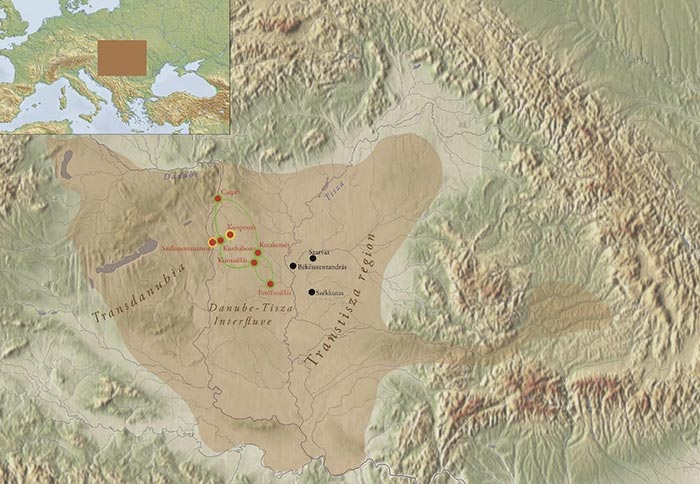
Carantanians
Carantania was a northern neighbor of the Lombard duchy of Friuli, which was inhabited by Slavs. According to Paul the Deacon, who was writing in the late 780s, those Slavs called their country Carantanum, by means of a corruption of the name of ancient Carnuntum (a former Roman legionary camp on the Danube, between Vienna and Bratislava). Carantanians were regarded as Slavs by the author of a report known as the Conversion of the Bavarians and Carantanians, and written in ca. 870 in order to defend the position of the archbishop of Salzburg against the claims of Methodius, the bishop of Pannonia.94 According to this text, a duke named Boruth was ruling over Carantania when he was attacked by Avars in ca. 740. He called for the military assistance of his Bavarian neighbors. The Bavarian duke Odilo (737–748) obliged, defeated the Avars, but in the process also subdued the Carantanians to his authority. Once Bavarian overlordship was established in Carantania, Odilo took with him as hostages Boruth’s son Cacatius and his nephew Chietmar (Hotimir). Both were baptized in Bavaria. During the 743 war between Odilo and Charles Martel’s two sons, Carloman and Pepin (the Mayors of the Palace in Austrasia and Neustria, respectively), Carantanian troops fought on the Bavarian side. The Bavarian domination cleared the field for missions of conversion to Christianity sent by Virgil, the new bishop of Salzburg (746–784). Many missionaries were of Bavarian origin, but some were Irish monks.
Moravians
Several Late Avar cemeteries dated to the last quarter of the 8th century are known from the lands north of the middle course of the river Danube, in what is today southern Slovakia and the valley of the Lower Morava [see image below]. By contrast, only two cemeteries have so far been found in Moravia (the eastern part of the present-day Czech Republic), along the middle and upper course of the Morava and along its tributary, the Dyje. In both Dolní Dunajovice and Hevlín, the latest graves may be dated by means of strap ends and belt mounts with human figures to the very end of the Late Avar period. (…)
The archaeological evidence pertaining to burial assemblages dated to the early 9th century is completely different. Shortly before or after 800, all traces of cremation—with or without barrows—disappear from the valley of the Morava river and southwestern Slovakia, two regions in which cremation had been the preferred burial rite during the previous centuries. This dramatic cultural change has often been interpreted as a direct influence of both Avar and Frankish burial rites, but it coincides in time with the adoption of Christianity by local elites. In spite of conversion, however, the representation of status through furnished burial continued well into the 9th century. Unlike Avar-age sites in Hungary and the surrounding regions, many men were buried in 9th-century Moravia together with their spurs, in addition to such weapons as battle axes, “winged” lance heads, or swords with high-quality steel blades of Frankish production.
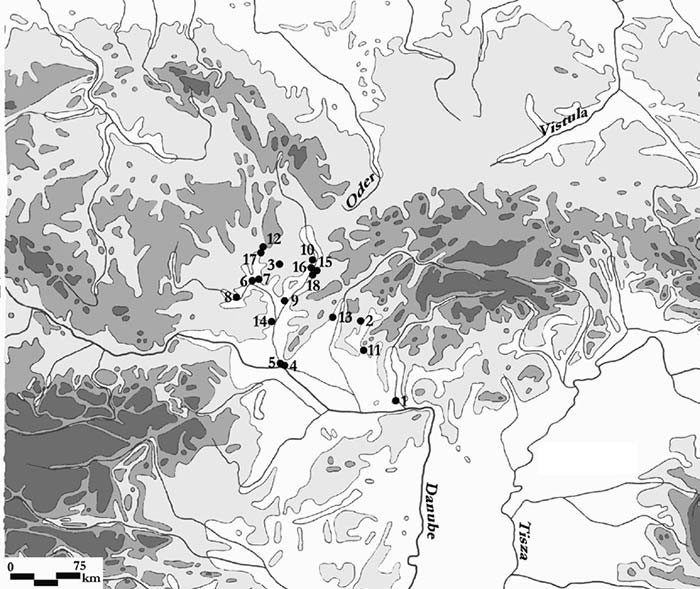
When the Magyars inflicted a crushing defeat on the Bavarians at Bratislava (July 4, 907), the fate of Moravia was sealed as well. Moravia and the Moravians disappear from the radar of the written sources, and historians and archaeologists alike believe that the polity collapsed as a result of the Magyar raids.
Magyars
(…) although there can be no doubt about the relations between Uelgi and the sites in Hungary attributed to the first generations of Magyars, those relations indicate a migration directly from the Trans-Ural lands, and not gradually, with several other stops in the forest-steppe and steppe zones of Eastern Europe. In the lands west of the Ural Mountains, the Magyars are now associated with the Kushnarenkovo (6th to 8th century) and Karaiakupovo (8th to 10th century) cultures, and with such burial sites as Sterlitamak (near Ufa, Bashkortostan) and Bol’shie Tigany (near Chistopol, Tatarstan).* However, the same problem with chronology makes it difficult to draw the model of a migration from the lands along the Middle Volga. Many parallels for the so typically Magyar sabretache plates found in Hungary are from that region. They have traditionally been dated to the 9th century, but more recent studies point to the coincidence in time between specimens found in Eastern Europe and those from Hungary.
* Ivanov, Drevnie ugry-mad’iary; Ivanov and Ivanova, “Uralo-sibirskie istoki”; Boldog et al., “From the ancient homelands,” p. 3; Ivanov, “Similarities.” Ivanov, “Similarities,” p. 562 points out that the migration out of the lands along of the Middle Volga is implied by the disappearance of both cultures (Kushnarenkovo and Karaiakupovo) in the mid-9th century. For the Kushnarenkovo culture, see Kazakov, “Kushnarenkovskie pamiatniki.” For the Karaiakupovo culture, see Mogil’nikov, “K probleme.”
Given that the Magyars are first mentioned in relation to events taking place in the Lower Danube area in the 830s, the Magyar sojourn in Etelköz must have been no longer than 60 years or so—a generation. (…)
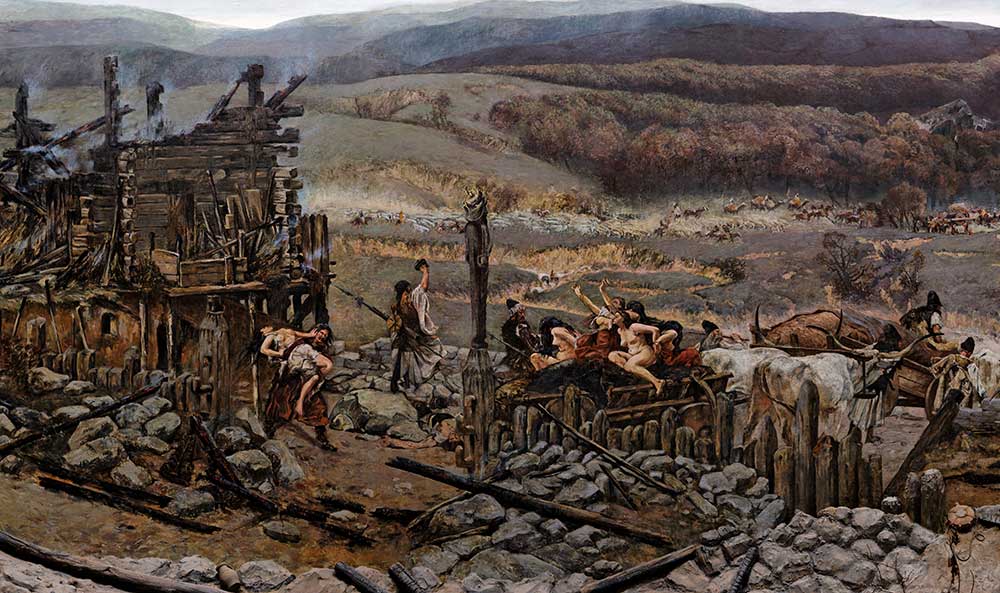
It has become obvious by now that one’s impression of the Magyars as “Easterners” and “steppe-like” was (and still is) primarily based on grave finds, while the settlement material is considerably more aligned with what is otherwise known from other contemporary settlement sites in Central and Southeastern Europe. The dominant feature on the 10th- and 11th-century settlements in Hungary is the sunken-floored building of rectangular plan, with a stone oven in a corner. Similarly, the pottery resulting from the excavation of settlement sites is very similar to that known from many other such sites in Eastern Europe. Moreover, while clear changes taking place in burial customs between ca. 900 and ca. 1100 are visible in the archaeological record from cemeteries, there are no substantial differences between 10th- and the 11th-century settlements in Hungary. (…)
As a matter of fact, the increasing quantity of paleobotanical and zooarchaeological data from 10th-century settlements strongly suggests that the economy of the first generations of Magyars in Hungary was anything but nomadic. To call those Magyars “half-nomad” is not only wrong, but also misleading, as it implies that they were half-way toward civilization, with social changes taking place that must have had material culture correlates otherwise visible in the burial customs.
Comments
The origin of “Slavs” (i.e. that of “Slavonic” as a language, whatever the ancestral Proto-Slavic ethnic make-up was) is almost as complicated as the origin of Albanians, Basques, Balts, or Finns. Their entry into history is very recent, with few reliable sources available until well into the Middle Ages. If you add our ignorance of their origin with the desire of every single researcher or amateur out there to connect them to the own region (or, still worse, to all the regions where they were historically attested), we are bound to find contradictory data and a constantly biased selection of information.
Furthermore, it is extremely complicated to connect any recent population to its ancestral (linguistic) one through haplogroups prevalent today, and just absurd to connect them through ancestral components. This, which was already suspected for many populations, has been confirmed recently for Basques in Olalde et al. (2019) and will be confirmed soon for Finns with a study of the Proto-Fennic populations in the Gulf of Finland.
NOTE. Yes, the “my parents look like Corded Ware in this PCA” had no sense. Ever. Why adult people would constantly engage in that kind of false 5,000-year-old connections instead of learning history – or their own family history – escapes all comprehension. But if something is certain about human nature, is that we will still see nativism and ancestry/haplogroup fetishism for any modern region or modern haplogroups and their historically attested ethnolinguistic groups.
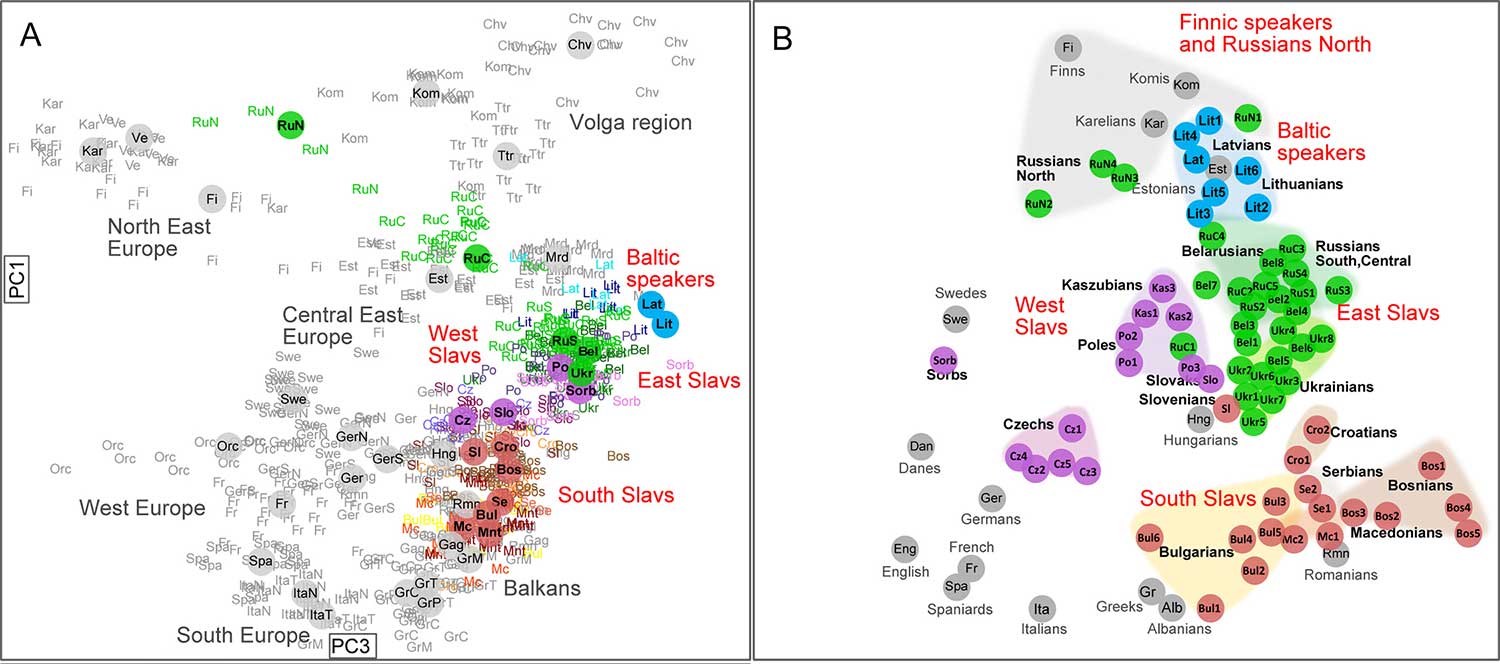
As you can see from my maps and writings, I prefer neat and simple concepts: in linguistics, in archaeology, and in population movements. Hence my aversion to this kind of infinite proto-historical accounts (and interpretations of them) necessary to ascertain the origins of recent peoples (Slavs in this case), and my usual preference for:
- Clear dialectal classifications, whether or not they can be as clear cut as I describe them. The only thing that sets Slavic apart from other recent languages is its connection with Baltic, luckily for both. Even though this connection is disputed by some linguists, and the question is always far from being resolved, a homeland of Proto-Balto-Slavic would almost necessarily need to be set to the north of the Carpathian Mountains in the Bronze Age (or at least close to them).
- A priori “pots = people” assumption, which may lead to important errors, but fewer than the usual “pots != people” of modern archaeologists. The traditional identification of the Common Slavic expansion with the Prague-Korchak culture – however undefined this culture may be – has clear advantages: it may be connected (although admittedly with many archaeological holes) with western cultures expanding east during the Bronze Age, and then west again after the Iron Age, and thus potentially also with Baltic.
- A simplistic “haplogroup expansion = ethnolinguistic expansion”, which is quite useful for prehistoric migrations, but enters into evident contradictions as we approach the Iron Age. Common Slavs may be speculatively (for all we know) associated with an expansion of recent R1a-M458 lineages – among other haplogroups – from the east, and possibly Balto-Slavic as an earlier expansion of older subclades from the west, as I proposed in A Clash of Chiefs.
NOTE. A dismissal of a connection with Baltic would leave Slavic a still more complicated orphan, and its dialectal classification within Late PIE more dubious. Its union with Balto-Slavic locates it close to Germanic, and thus as a Bronze Age North-West Indo-European dialect close to northern Germany. So bear with me in accepting this connection, or enter the linguistic hell of arguing for Indo-Slavonic of R1a-Z93 mixed with Temematic….

NOTE. The connection of most R1a-Z280 lineages is more obviously done with ancient Finno-Ugric peoples, as it is clear now (see here and here).
Slavs appeared first in the Danube?
No matter what my personal preference is, one can’t ignore the growing evidence, and it seems that Florin Curta‘s long-lasting view of a Danubian origin of expansion for Common Slavic, including its condition as a lingua franca of late Avars, won’t be easy to reject any time soon:
1) Theories concerning Chernyakhov as a Slavic homeland will apparently need to be fully rejected, due to the Germanic-like ancestry that will be reported in the study by Järve et al. (2019).
EDIT (3 MAY 2019). From their poster Shift in the genetic landscape of the western Eurasian Steppe not due to Scythian dominance, but rather at the transition to the Chernyakhov culture (Ostrogoths) (download PDF):
(…) the transition from the Scythian to the Chernyakhov culture (~2,100–1,700 cal BP) does mark a shift in the Ponto-Caspian genetic landscape. Our results agree well with the Ostrogothic origins of the Chernyakhov culture and support the hypothesis that Scythian dominance was cultural rather than achieved through population replacement.
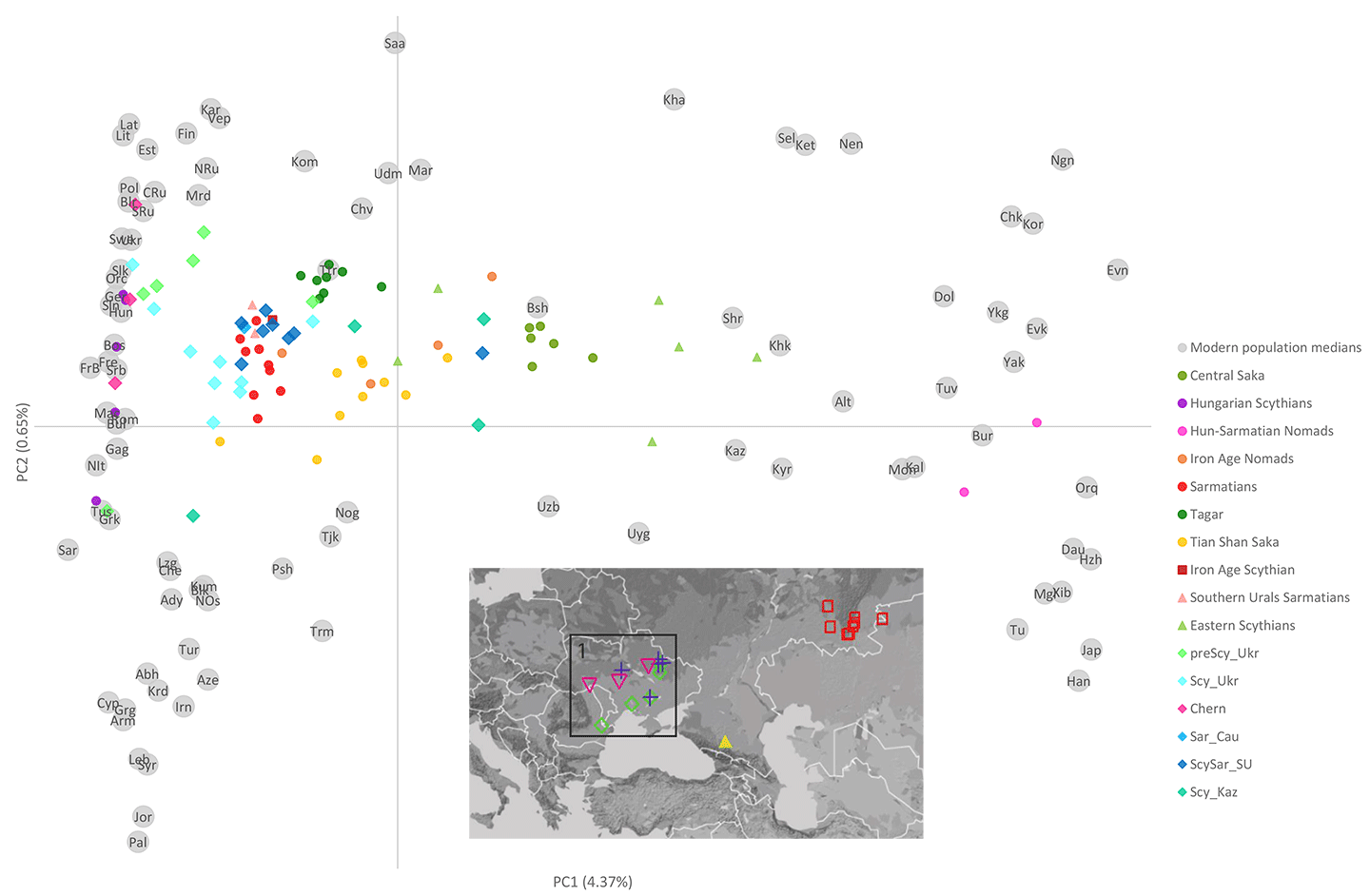
2) Therefore, unless Przeworsk shows the traditionally described mixture of populations in terms of ancestry and/or haplogroups, it will also be a sign of East Germanic peoples expanding south (and potentially displacing the ancestors of Slavs in either direction, east or south).
It would seem we are stuck in a Danubian vs. Kievan homeland for Common Slavs, then:
3) About the homeland in the Kiev culture, two early Avar females from Szólád have been commented to cluster “among Modern Slavic populations” based on some data in Amorim et al. (2018).
Rather than supporting an origin of Slavs in common with modern Russians, Poles, and Ukranians as observed in the PCA, though, the admixture of AV1 and AV2 (ca. AD 540-640) paradoxically supports an admixture of Modern Slavs of Eastern Europe in common with early Avar peoples (an Altaic-speaking population) and other steppe groups with an origin in East Asia… So this admixture would actually support a western origin of the Common Slavs with which East Asian Avars may have admixed, and whose descendants are necessarily sampled at later times.
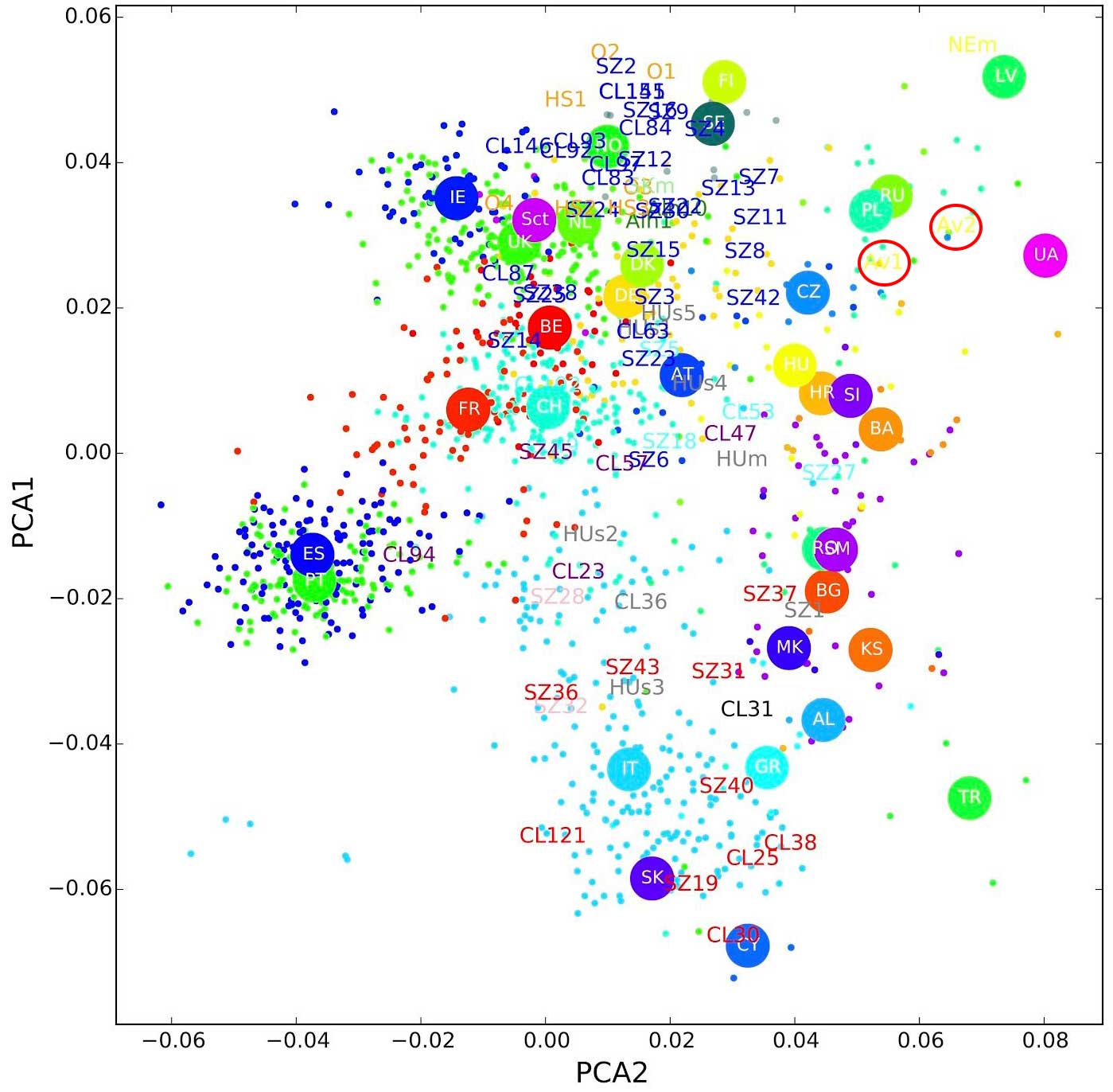
4) Favouring Curta’s Danubian origin (or even an origin near Bohemia) at the moment are thus:
- The “western” cluster of Early Slavs from Brandýsek, Bohemia (ca. AD 600-900).
- Two likely Slavic individuals from Usedom, in Mecklenburg-Vorpommern (AD 1200) show hg. R1a-M458 and E1b-M215 (Freder 2010).
- An early West Slav individual from Hrádek nad Nisou in Northern Bohemia (ca. AD 1330) also shows E1b-M215 (Vanek et al. 2015).
- One sample from Székkutas-Kápolnadülő (SzK/239) among middle or late Avars (ca. AD 650-710), a supposed Slavonic-speaking polity, of hg. E1b-V13.
- Two samples from Karosc (K1/13, and K2/6) among Hungarian conquerors (ca. AD 895-950), likely both of hg. E1b-V13, probably connected to the alliance with Moravian elites.
- Possibly a West Slavic sample from Poland in the High Middle Ages (see below).
A later Hungarian sample (II/53) from the Royal Basilica, where King Béla was interred, of hg. E1b1, supports the importance of this haplogroup among elite conquerors, although its original relation to the other buried individuals is unknown.
NOTE. You can see all ancient samples of haplogroup E to date on this Map of ancient E samples, with care to identify the proper subclades related to south-eastern Europe. About the ancestral origin of the haplogroup in Europe, you may read Potential extra Iberomaurusian-related gene flow into European farmers, by Chad Rohlfsen.
Even assuming that the R1a sample reported from the late Avar period is of a subclade typically associated with Slavs (I know, circular reasoning here), which is not warranted, we would have already 6 E1b1b vs. 1-2 R1a-M458 in populations that can be actually assumed to represent early Slavonic speakers (unlike many earlier cultures potentially associated with them), clearly earlier than other Slavic-speaking populations that will be sampled in eastern Europe. It is more and more likely that Early Slavs are going to strengthen Curta’s view, and this may somehow complicate the link of Proto-Slavic with eastern European BA cultures like Trzciniec or Lusatian.
NOTE. I am still expecting a clear expansion associated with Prague-Korchak, though, including a connection with bottlenecks based on R1a-M458 in the Middle Ages, whether the expansion is eventually shown to be from the west (i.e. Bohemia -> Prague -> Korchak), or from the east (i.e. Kiev -> Korchack -> Prague), and whether or not this cultural community was later replaced by other ‘true’ Slavonic-speaking cultures through acculturation or population movements.
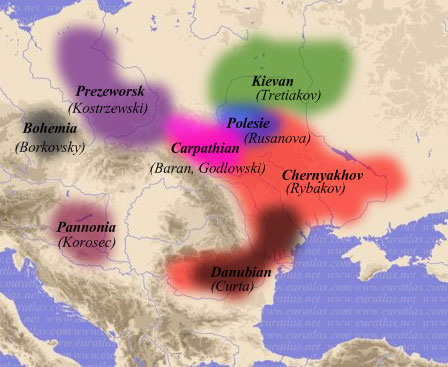
5) Back to Przeworsk and the “north of the Carpathians” homeland (i.e. between the Upper Oder and the Upper Dniester), but compatible with Curta’s view: Even if Common Slavic is eventually evidenced to be driven by small migrations north and south of the Danube during the Roman Iron Age, before turning into a mostly “R1a-rich” migration or acculturation to the north in Bohemia and then east (which is what this early E1b-V13 connection suggests), this does not dismiss the traditional idea that Late Bronze Age – Iron Age central-eastern Europe was the Proto-Slavic homeland, i.e. likely the Pomeranian culture disturbed by the East Germanic migrations first (in Przeworsk), and the migrations of steppe nomads later (around the Danube).
Even without taking into account the connection with Baltic, the relevance of haplogroup E1b-V13 among Early Slavs may well be a sign of an ancestral population from the northern or eastern Carpathian region, supported by the finding of this haplogroup among the westernmost Scythians. The expansion of some modern E1b-CTS1273 lineages may link Slavic ancestrally with the Lusatian culture, which is an eastern (very specific) Urnfield culture group, stemming from central-east Europe.
An important paper in this respect is the upcoming Zenczak et al., where another hg. E1b1 will be added to the list above: such a sample is expected from Poland (from Kowalewko, Maslomecz, Legowo or Niemcza), either from the Roman Iron Age or Early Middle Ages, close to an early population of likely Scandinavian origin (eight I1 samples), apart from other varied haplogroups, with little relevance of R1a. Whether this E-V13 sample is an Iron Age one (justifying the bottleneck under E-V13 to the south) or, maybe more likely, a late one from the Middle Ages (maybe supporting a connection of the Gothic/Slavic E1b bottleneck with southern Chernyakhov or further west along the Danube) is unclear.
The finding of south-eastern European ancestry and lineages in both, Early Slavs and East Germanic tribes* suggests therefore a Slavonic homeland near (or within) the Przeworsk culture, close to the Albanoid one, as proposed based on topohydronymy. This may point to a complex process of acculturation of different eastern European populations which formed alliances, as was common during the Iron Age and later periods, and which cannot be interpreted as a clear picture of their languages’ original homeland and ancestral peoples (in the case of East Germanic tribes, apparently originally expanding from Scandinavia under strong I1 bottlenecks).
* Iberian samples of the Visigothic period in Spain show up to 25% E1b-V13 samples, with a mixture of haplogroups including local and foreign lineages, as well as some more E1b-V13 samples later during the Muslim period. Out of the two E1b samples from Longobards in Amorim et al. (2018), only SZ18 from Szólád (ca. AD 412-604) is within E1b-V13, in a very specific early branch (SNP M35.2), further locating the expansion of hg. E1b-V13 near the Danube. Samples of haplogroup J (maybe J2a) or G2a among Germanic tribes (and possibly in Poland’s Roman Iron Age / Early Middle Ages) are impossible to compare with early Hungarian ones without precise subclades.

I already interpreted the earlier Slavic samples we had as a sign of a Carpathian origin and very recent bottlenecks under R1a lineages among Modern Slavs:
The finding of haplogroup E1b1b-M215 in two independent early West Slavic individuals further supports that the current distribution of R1a1a1b1a-Z282 lineages in Slavic populations is the product of recent bottlenecks. The lack of a precise subclade within the E1b1b-M215 tree precludes a proper interpretation of a potential origin, but they are probably under European E1b1b1a1b1-L618 subclade E1b1b1a1b1a-V13 (formed ca. 6100 BC, TMRCA ca. 2800 BC), possibly under the mutation CTS1273 (formed ca. 2600 BC, TMRCA ca. 2000 BC), in common with other ancient populations around the Carpathians (see below §viii.11. Thracians and Albanians). This gross geographic origin would support the studies of the Common Slavic homeland based on toponymy (Figure 66), which place it roughly between the Upper Oder and the Upper Dniester, north of the Carpathians (Udolph 1997, 2016).
EDIT (8 APR 2019): Another interesting data is the haplogroup distribution among Modern Slavs and neighbouring peoples (see Wikipedia). For example, the bottleneck seen in Modern Albanians, under Z5017 subclade, also points to an origin of the expansion of E1b-V13 subclades among multiethnic groups around the Lower Danube coinciding with the Roman Iron Age, given the estimates for the arrival of Proto-Albanian close to the Latin and Greek linguistic frontier.
Remarkable is also its distribution among Rusyns, East Slavs from the Carpathians not associated with the Kievan Rus’, isolated thus quite soon from East Slavic expansions to the east. They were reported to show ca. 35% hg. E1b-V13 globally in FTDNA, with a frequency similar to or higher than R1a, in common with South Slavic peoples*, reflecting thus a situation similar to the source of East Slavs before further R1a-based bottlenecks (and/or acculturation events) to the east:
* Although probably due in part to founder effects and biased familial sampling, this should be assumed to be common to all FTDNA sampling, anyway.
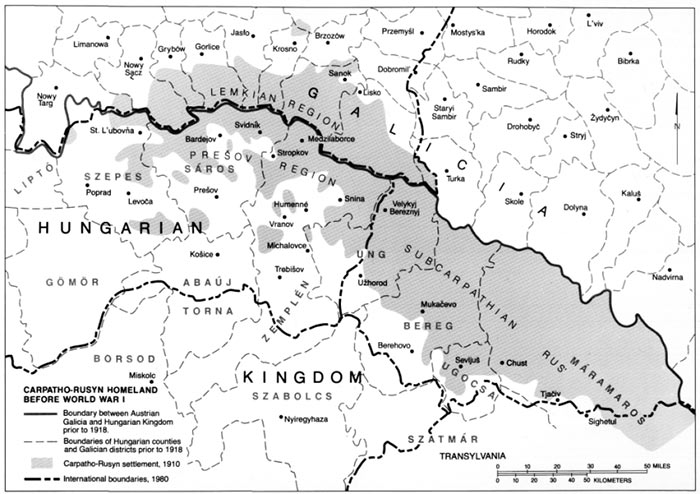
Repeating what should be already evident: in complex organizations and/or demographically dense populations (more common since the Iron Age), we can’t expect language change to happen in the same way as during the known Neolithic or Chalcolithic population replacements, be it in Finland, Hungary, Iberia, or Poland. For example, no matter whether Romans (2nd c. BC) brought some R1b-U152 and other Mediterranean lineages to Iberia; Germanic peoples entering Hispania (AD 5th c.) were of typically Germanic lineages or not; Muslims who spoke mainly Berber (AD 8th c.) and were mainly of hg. E1b-M81 (and J?) brought North African ancestry; etc. the language or languages of Iberia changed (or not) with the political landscape: neither with radical population replacements (or full population continuity), nor with the dominant haplogroups’ ancestral language.
Y-chromosome haplogroups are, in those cases, useful for ascertaining a more recent origin of the population. Like the finding of certain R1a-Z645, I2a-L621 & N-L392 lineages among Hungarians shows a recent origin near the Trans-Urals forest-steppes, or the finding of I1, R1b-U106 & E1b-V13 among Visigoths shows a recent origin near the Danube, the finding of Early Slavs (ca. AD 6th-7th c.) originally with small elite groups of hg. R1a-M458 & E1b-V13 from the Lower/Middle Danube – if strengthened with more Early Slavic samples, with Slavonic partially expanding as a lingua franca in some regions – is not necessarily representative of the Proto-Slavic community, just as it is clearly not representative of the later expansion of Slavic dialects. It would be representative, though, of the same processes of acculturation repeated all over Eurasia at least since the Iron Age, where no genetic continuity can be found with ancestral languages.
Related
- Aquitanians and Iberians of haplogroup R1b are exactly like Indo-Iranians and Balto-Slavs of haplogroup R1a
- Magyar tribes brought R1a-Z645, I2a-L621, and N1a-L392(xB197) lineages to the Carpathian Basin
- R1a-Z280 and R1a-Z93 shared by ancient Finno-Ugric populations; N1c-Tat expanded with Micro-Altaic
- Scytho-Siberians of Aldy-Bel and Sagly, of haplogroup R1a-Z93, Q1b-L54, and N
- Mitogenomes from Avar nomadic elite show Inner Asian origin
- The complex origin of Samoyedic-speaking populations
- Corded Ware—Uralic (IV): Hg R1a and N in Finno-Ugric and Samoyedic expansions
- Corded Ware—Uralic (III): “Siberian ancestry” and Ugric-Samoyedic expansions
- Corded Ware—Uralic (II): Finno-Permic and the expansion of N-L392/Siberian ancestry
- The traditional multilingualism of Siberian populations
- Iron Age bottleneck of the Proto-Fennic population in Estonia
- Y-DNA haplogroups of Tuvinian tribes show little effect of the Mongol expansion
- Corded Ware—Uralic (I): Differences and similarities with Yamna
- Haplogroup R1a and CWC ancestry predominate in Fennic, Ugric, and Samoyedic groups